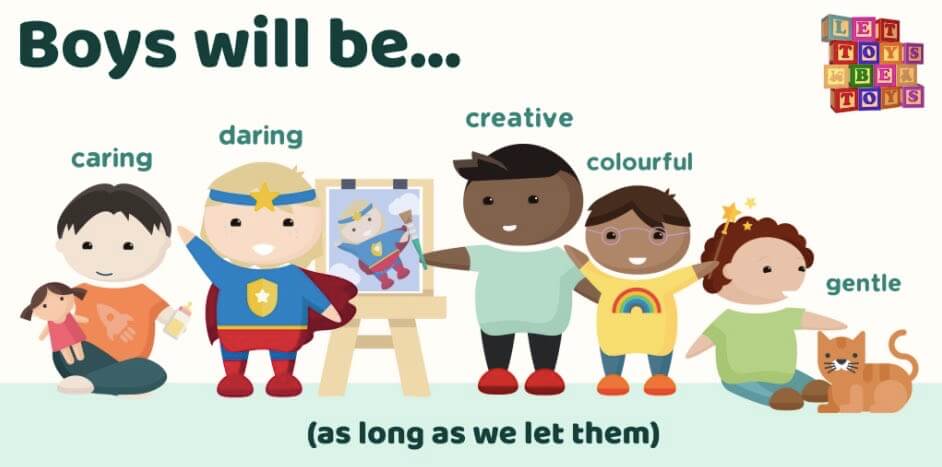Something I never really noticed before becoming a parent was how heavily gendered toys can be. The impact of this on the way children play and develop is clear for all to see. Not too long after I became a dad and started blogging, I became aware of the Let Toys Be Toys campaign.

The campaign exists to highlight where retailers and manufacturers are reinforcing stereotypes by gendering their toys. That, however is only part of the story. The campaign has grown to include a Toymark scheme which acknowledges good practice and resources have been created to help teachers and those working in the early years sector to break down gender stereotypes. It’s also expanded to include a Let Books be Books campaign to encourage children to read what they want.
It’s certainly a campaign that has caught the public imagination and I was over the moon when Megan Perryman, who has been involved since the very earliest days, agreed to do a Q&A and me all about it. Here’s what Megan had to say.
How long has the campaign been running now and what was the inspiration for starting it?
“In 2012, not long after my youngest child was born, I visited the social networking site Mumsnet to complain about ‘Boys’ and ‘Girls’ signs in shops selling toys and found that many others had been thinking the same thing. We were all surprised to see that the toy industry was rife with stereotypes, ones which would have been seen as quite old-fashioned during our own childhoods.
“The most shocking moment for me was realising I couldn’t easily shop for toys with my daughter once she learned to read, because she would refuse to buy anything labelled as “boys.” Along with the other participants in the discussion we decided to form a campaign and it’s been running ever since, still run by volunteers fitting campaigning in and around day jobs and family life.”
Can you give some examples of just how badly gendered toys can be?
“In 2012 half the UK’s major toy retailers were explicitly labelling their shelves as “Boys’ Toys” and “Girls’ Toys”. It was very common to see books labelled as bedtime stories for girls or colouring for boys.
“The stereotypes that accompanied these were clear: Boys were expected to be explorers, to learn new things and to be aggressive whilst they were doing it! Girls were expected to look after babies, clean the house and, above all, be pretty. The stereotypes didn’t seem to apply to any real-life child that I knew, all of whom had a range of interests; they were caricatures of what an adult thought a child should be.”

What is the impact on children of toys being gendered?
“In the short-term, gendered marketing encourages children away from their natural interests. Given the opportunity most children will enjoy a diverse range of toys. I’ve seen this with my own children but also in the classroom in my job as a primary school teacher. If marketing messages tell a child that only half of those toys are acceptable, children can be put off those toys, stopping their enjoyment and preventing them from developing a range of skills.
“Those children who are confident enough to ignore the signs can be bullied and made to feel different. There are of course also long-term effects of encouraging boys and girls down separate paths. Toys promoting science, technology, engineering and maths are more likely to be marketed towards boys and we see a corresponding lack of girls taking up these subjects as they get older. For instance, only 22% of A-Level physics students in 2019 were female. Equally, boys are steered away from toys that promote empathy and there is a lack of men in caring professions. Another example: Only 11% of UK nurses are male for example.
“We live in a heavily gendered world where power and wealth are more likely to be held by men (just a third of our current MPs are female) and men are three times more likely to commit suicide than women. Our lives are governed by stereotypes of who can do which jobs and what the role of mums or dads should be. In short, a heavily gendered world does a disservice to us all. That’s not to say it’s as simple as drawing a direct link from toys to adult injustice but our views on what it means to be male or female begin from our very earliest experiences.”
What do you say to people who don’t consider this an issue?
“One single incident of stereotyping is unlikely to be significant so I understand why some people feel that way. The damage, however, is done by thousands of instances happening throughout a child’s life, gradually turning them away from their true interests and encouraging them to behave in a stereotypical way. The issues we campaign about are part of a much bigger picture of inequality.”
The campaign must have had some successes over the years. Can you highlight some?
“We were really pleased that after our first year of campaigning, through letter writing, social media campaigning and meetings with the toy industry, we saw all major UK supermarkets, department stores and toyshops agree to remove “boys” and “girls” signs from toy aisles. We’ve also been pleased to see the changes we have made via our Let Books Be Books campaign to the publishing industry, with the UK’s major children’s publishers agreeing to stop explicitly labelling books as “boys” or “girls” as well. Our Toymark scheme, which celebrates shops that sell in an inclusive way, now has over 50 toy sellers listed. We have developed a range of resources for teachers and Early Years practitioners and we continue to support educators to challenge stereotypes at every level.
“We’re really fortunate that Let Toys Be Toys is now often consulted with by public, private and the voluntary sectors and it’s great to have the voice of our supporters being heard.”
Do you think gendering of toys is getting worse or are retailers and families more aware of this as an issue?
“There have been huge successes since we began in 2012 but I would never become complacent. Attitudes can shift one way or another and it’s important to keep the danger of stereotyping on everyone’s agenda. The 1990s saw more instances of gender stereotyping in toy marketing than the 1980s for example, it’s easy for society to move backwards.”

Is gendering of toys a bigger problem for boys or girls or is it a relatively equal spilt?
“That’s a great question, and a tricky one to answer. Many would say that girls miss out the most as the toys aimed at them tend to be more passive and toys related to science, technology, engineering and maths are more likely to be marketed at boys. There’s certainly some credence to that, although I would say that all children lose out when it comes to gender stereotypes because they stop each child from developing in a rounded way. Boys need toys such as dolls to support the development of empathy and communication skills so they certainly don’t benefit from being denied them.”
I once did a review of a bracelet making kit and made a remark about how it seemed to be aimed at girls. The manufacturer came back to me and said they wanted to make the toy gender neutral, but the problem they had was parents were avoiding it because they felt it wasn’t suitable for their sons. Do you think it is largely parents who need to have their perceptions challenged or retailers / manufacturers?
“What’s been fascinating about this journey is that everybody seems to blame each other. Everyone I’ve spoken to, whether they are a parent or work in the toy industry, has agreed that children don’t conform to stereotypes. And they all seem to think there is someone else out there who does hold this belief. In reality, I think most of us are on the same page.”
What next for Let Toys be Toys?
“We’ll continue to work with the toy and publishing industries, supporting them to make changes where necessary and promoting our #Just4Asks. Now that explicit signage has gone we’re interested in how colours and imagery might suggest “boy” or “girl” interests. For example, we’ve been asking our supporters what they’re seeing lately in advertising aimed at children. We’re continuing to grow our Toymark award scheme which celebrates UK retailers with best practice in marketing inclusively to children, without the gender stereotypes. We’ll also continue our links with the education sector, supporting schools and teachers where needed.”
If people want to get involved with the campaign, how can they?
“People who want to get involved can join in the conversation on Twitter, Facebook or Instagram, and share experiences of any gendered marketing that they have come across, as well as examples of good practice that is smashing stereotypes. They can also support retailers that are marketing inclusively to all children by nominating them for our Toymark award, and shopping with our awarded retailers when buying toys, books and bikes.”
Where can people find details of the campaign online?
“We’re on Twitter, Facebook, LinkedIn and Instagram at @lettoysbetoys and here is our website.”







